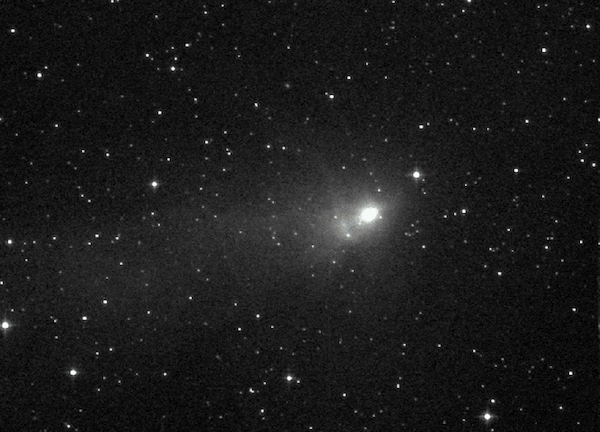.
Distant comets, sailing quietly through the cold recesses of the solar system beyond Mars, usually don't change much from night to night. Comet PanSTARRS (C/2016 R2) is different. It's changing by the hour. Click to play a 2-hour movie recorded on Christmas night by astrophotographer Michael Jäger of Jauerling, Austria, and watch what happens to the indicated cloud:
-
C/2016 R2 Dec 25 Knots And Expanding Shell
Taken by michael jäger on December 25, 2017 @ Jauerling Austria

Details:
Unusual tail structure in an animation
GIF centered on nucleus
22.14 - 00.32 UT
42x200sec filter blue
10/4 Newton Asi 1600 2x2
The movie shows a whole section of the comet's tail disconnecting and billowing away. Jäger has been tracking this comet for months, and this kind of activity is not unusual. On multiple occasions since November, he has recorded blobsmoving away from the nucleus as well as apparent activity in the comet's inner jets--each time in just a few hours. Comet PanSTARRS (C/2016 R2) is remarkably active.
What's happening? Sunlight could be vaporizing fragile ices in the comet's core, exposing caverns of sublimating gas and puffing clouds into space. Or the comet might be experiencing magnetic storms. Magnetic storms in comet tails have been observed before--most famously in 2007 when NASA's STEREO spacecraft watched a CME crash into Comet Encke. Encke's tail was ripped into forms akin to those Jäger has been seeing in Comet PanSTARRS (C/2016 R2). Given the quiet state of solar activity, however, the former hypothesis seems more likely.
Comet PanSTARRS (C/2016 R2) is currently moving through the constellation Taurus, shining with the integrated brightness of an 11th magnitude star. This means it is a suitable target for large backyard telescopes equipped with modern deep-sky cameras. Experienced observers like Jäger may be able to see more action in the nights ahead. Monitoring is encouraged.
Quelle: Spaceweather

